
Publications Plotting A New Course: The Impact Of Brexit On M&A Activity
- Publications
Plotting A New Course: The Impact Of Brexit On M&A Activity
- Christopher Kummer

SHARE:
By Deloitte
Summary
In the aftermath of the EU referendum vote, the reaction from currency and stock markets has been swift. It is clear that Brexit has shaken investor confidence. However, M&A markets are typically driven by longer term decision making processes. Brexit has created uncertainties and some M&A plans are being put on hold. But we think the post-Brexit tumult creates opportunities as well. In the coming months we expect there will be both threats to M&A dealmakers and unique opportunities for them.
Prior to the referendum vote, M&A market activity in the UK, particularly on larger and private equity-led deals, had started to slow down, although in some areas such as the domestic mid-market, transaction activity had remained relatively robust and largely consistent with prior years.
It is clear that uncertainty tends to be a drag on M&A activities and policy-makers can now help dealmakers with clarity and guidance on the UK’s new economic and trading environment as soon as possible. Indeed, there is strong historical evidence that M&A markets tend to recover quickly once uncertainty subsides.
The overwhelming sentiment from a Deloitte snap poll of global M&A advisors immediately after the Brexit vote suggests a large proportion of companies are planning a “wait and see” approach to UK-related deals. M&A markets appear to be approaching the post-Brexit world in a rational and considered way. Clearly, there is much for M&A dealmakers to think through and this could potentially elongate the dealmaking process and drive additional due diligence considerations around areas such as exposure to FX and trade arrangements. Companies may also need to consider short-term actions to preserve value in their assets as uncertainty in the markets may provide some headwinds to the M&A processes.
But for some there is a positive side to the turbulence. Our snap poll indicated that opportunity hunters outnumbered those avoiding the UK by a significant margin. In the short term, the depreciation of the pound and some falls in share prices mean that some UK-based companies might be available at attractive valuations. Indeed, some of the companies that announced M&A deals immediately post Brexit have already highlighted how currency depreciation has spurred their decision to go ahead.
There are likely to be further opportunities for FTSE 350 companies as well. Despite the volatility in stock markets, their strong corporate cash reserves and relatively high price to earnings multiples could provide them with the ammunition to buy overseas assets and diversify their earnings.
On the funding side, one further outcome of the Brexit vote is that it could potentially accelerate the shift from banks to alternative lending funds in the UK-leveraged finance mid-market as these funds take the opportunity to keep the M&A markets active.
One thing is clear, dealmakers may be cautious, but they have not gone away. Deals are still getting done, and attractive, strategically important acquisitions are still demanding premium valuations.
A time of high uncertainty and of volatility in markets can be an opportune one as well, and some may be ready to pounce. There will always be savvy dealmakers who will be looking to turn today’s situation into opportunity. (Iain Macmillan, Managing Partner, Global M&A Services)
About the research: This report provides insights on the potential impact of Brexit on M&A activity. The insights are based on the secondary analysis, snap poll conducted by Deloitte within its global member firm network to gauge the sentiment of global dealmakers following the EU referendum vote, as well as analysis based on data from Thomson One Banker and Bloomberg.
The UK M&A market in 2016
The UK is one of the major global players in M&A. Not only does it have a significant domestic M&A market but London as a financial centre plays a crucial role in funding corporate and private equity (PE) activities globally.
In addition, the UK has a wide range of skills across the M&A life cycle, from deal advisory all the way through to post-merger integration.
Historically, the UK M&A market is one of the most active in Europe. Global investors often use the UK as the gateway for market expansion in Europe. In 2015, UK-based companies were involved in $488bn worth of deals, the highest year-end figure since 2007. This was equivalent to 44% of all the deals done by European companies.
Following a record year in 2015, global M&A had already slowed in the first half of this year, down by 15% by volume and 32% in terms of disclosed deal values with the majority of this slowdown at the larger end of transactions. The global slowdown in M&A activity has been driven by worldwide economic concerns, led by a slowdown in China, the volatility in the credit markets, as well as by political uncertainty both sides of the Atlantic and various regulatory pressures that are impacting M&A transactions. In addition, following the record levels of M&A deals last year, a period of ingestion should be expected, as some acquirers focus on driving synergy returns.
Since the beginning of 2016, ahead of the EU referendum vote, the UK M&A market has been slowing down. In the first half of 2016, M&A volume fell by 20% while disclosed values were down by 68% over the same period last year. The hardest hit has been inbound M&A deal value into the UK, which is down by 75% (albeit some of this shortfall can be attributed to companies waiting for the outcome of the referendum).
The drop in confidence has impacted both the corporate as well as the PE sector. In recent years, the PE sector has driven growth in UK M&A. The chart below shows a split of deal volume by corporate and PE for UK involved M&A (including inbound, outbound and domestic). Between the second half of 2013 and the second half of 2015, UK PE deal volume grew at a compound annual growth rate (CAGR) of 9%, whereas corporate sector deals rose by only 3%. As from the first half of this year, there has been a significant drop in PE deals, which were down by 29% by volume over the first half of 2015, while corporate sector M&A fell by 17% by volume over the same period.
However, turning to UK domestic deals, it seems the below $1bn segment volumes in the domestic market has held up well, despite the period of uncertainty. In H1 2016 deal volumes in this segment declined by just 10% compared to H1 2015, while the deal values remained strong at $13bn, broadly on par with previous year.
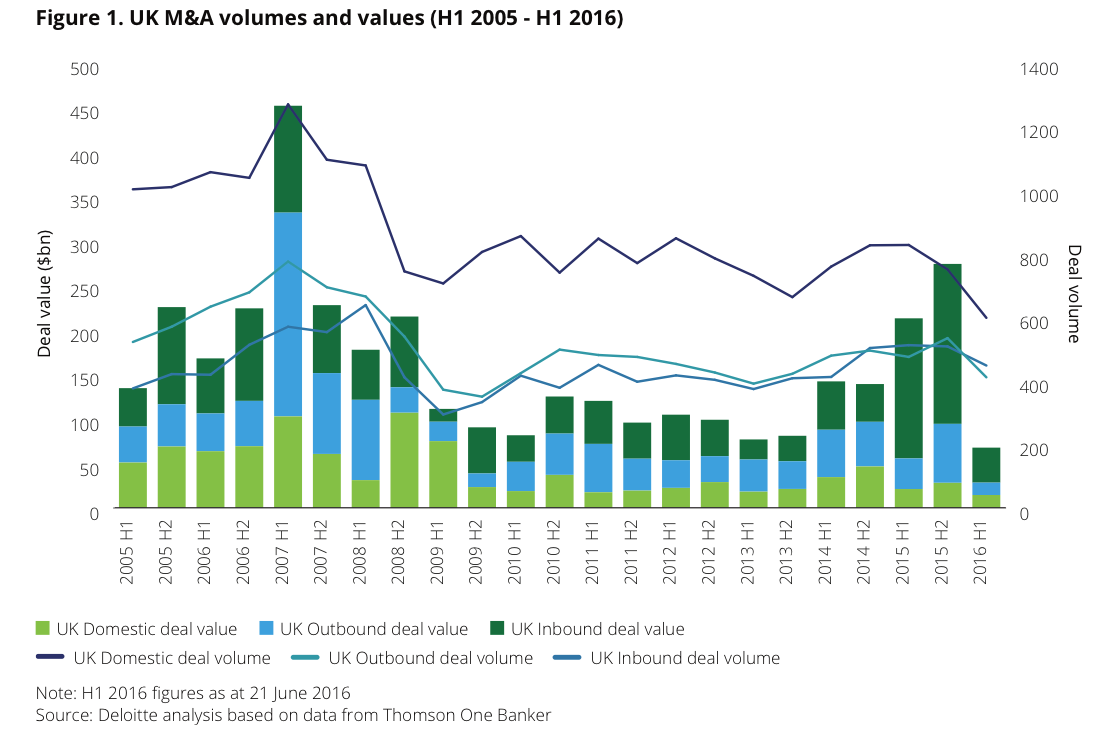
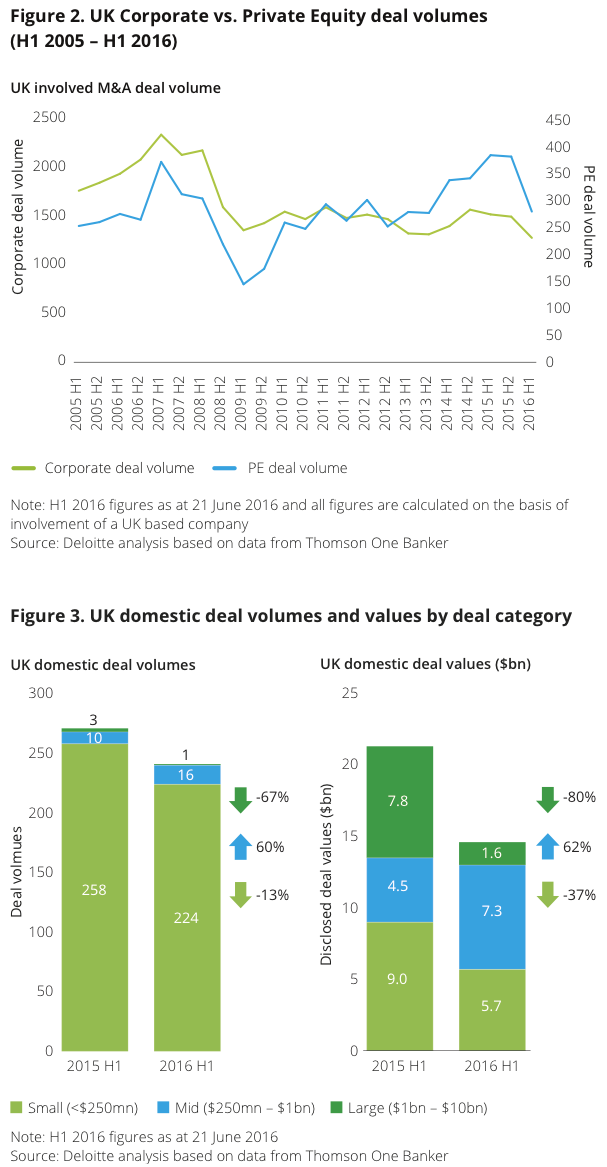
Headwinds and tailwinds for M&A following Brexit vote
Headwinds
Uncertainty
The most telling and immediate impact of the Brexit referendum on M&A has been a dramatic rise in UK policy uncertainty following the referendum vote. Our analysis shows that uncertainty is the one of the biggest drags on M&A and there is a material correlation between policy changes and M&A appetite. At the same time, M&A tends to recover at pace, when policy certainty starts to recover, as was evidenced in the periods in between 2003-2007 and more recently in between 2013-2015. Therefore the onus is now on the UK Government to rapidly provide policy certainty and reinstate market confidence.
Over the next few months political uncertainty across the globe may have an impact on M&A markets. We expect dealmakers to pay close attention to the US elections later this year and soon thereafter in 2017 elections in France, the Netherlands and Germany.
Investor confidence
Deloitte ran a snap poll within its global member firms network to gauge the sentiment of global dealmakers following the EU referendum vote. We received responses from 24 countries, including the US, China, Japan and many EU countries.
Our survey indicated that the overall majority of the dealmakers have taken a “wait and see” approach towards M&A opportunities in the UK and indeed it is noteworthy that 23% see a potential increase in opportunity, as compared to 4% who see a decrease.
The poll results also show that the most important factor for dealmakers is for the UK to provide clarity on the terms of trade agreements with the EU and other countries and on the outcome of the exit negotiations with the EU. We expect dealmakers will be closely monitoring signs of any agreement on trade and policy negotiations in the coming months, both with EU and other major trading nations.

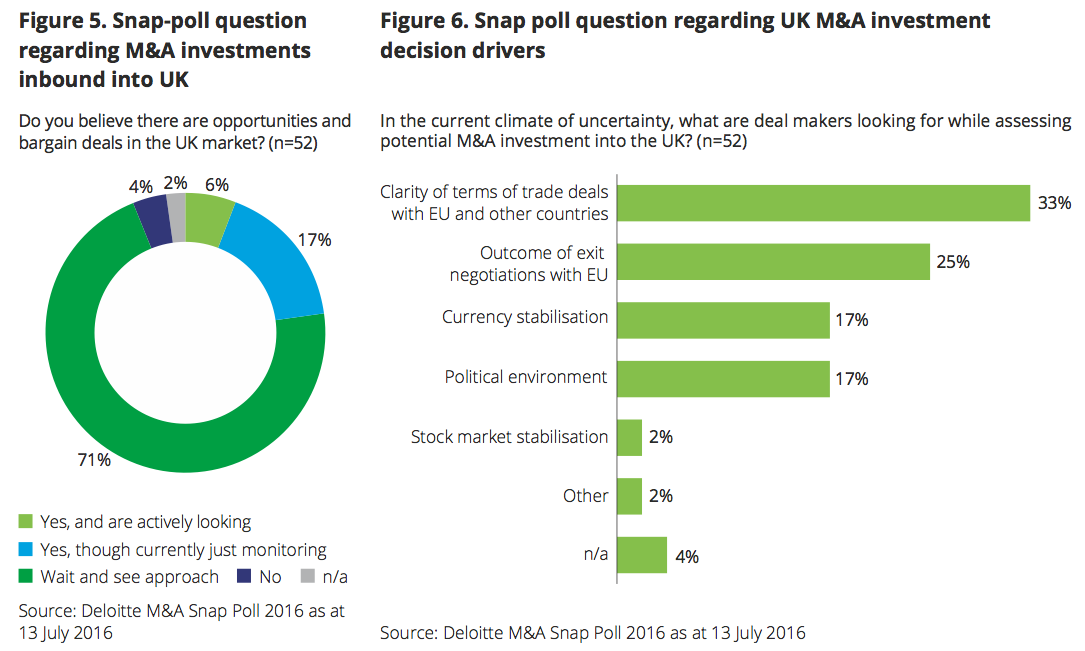
Tailwinds
Currency fluctuations and impact on M&A
Following the Brexit vote the British pound suffered its largest two-day fall against the US dollar since a floating exchange rate was reintroduced.
The fall in the currency is taking place against a backdrop of sluggish growth in global trade, a slowdown in China, ultra-low interest rates, a large UK current account deficit and the uncertain consequences of the future exit from the EU.
In the last few years, the impact of currency devaluation on M&A is unclear. During the global financial crisis, when the British pound experienced a depreciation of 19% between 2007 and 2009 against the US dollar, it was accompanied by a sharp 42% decline in UK M&A activity. This was a period of great economic uncertainty and some of the potential benefits of a weaker British pound failed to materialise. For instance, a study made by the Bank of England of the 2007-09 depreciation found there was no major boost to exports during that period.
However, during the most recent M&A wave between 2013 and 2015, US dollar appreciation against the British pound provoked opportunistic activity by overseas buyers in the UK M&A market. The 11% decline of the British pound against the US dollar helped to spur an overall 20% increase in M&A activity. During this period there was a 30% increase in inbound M&A activity into UK, largely driven by the US companies who were picking up UK assets at attractive valuations. This was also against the backdrop of a UK economy that was growing faster than other EU countries.
One conclusion is that we should not expect M&A investment into the UK solely because the currency is weak. M&A investments are driven by business confidence and the growth prospects of the underlying business. However, if the targeted business has attractive growth prospects the weaker British pound will make the deal look more attractive. Indeed, in the immediate aftermath of the Brexit vote, there were at least two major inbound acquisitions of UK consumer facing businesses that have cited weaker British pound as one of the key drivers for the transaction. Further, following the volatility in the FTSE 350 many companies may start to look attractive in US dollar terms.


FTSE 100 and 250 – a window of opportunity to pursue cross-border M&A
Immediately after the EU referendum vote, both the FTSE 100 and FTSE 250 fell heavily. The hardest hit sectors were real estate, financial services and travel while pharmaceuticals, tobacco and oil & gas were among those that performed well.
In the subsequent two weeks the FTSE 100 index recovered well, erasing its post-Brexit losses and proving the best-performing European index during the period.
This bounce back was fuelled in part by the global business profile of FTSE 100 companies, which earn around three-quarters of their revenues from outside the UK. The pound’s fall means their dollar earnings will be worth more in British pound terms.
It is also worth noting that despite the post-Brexit weakness of the British pound it remains higher than it was versus the euro back in 2011. In addition, the FTSE 100 is currently trading at a higher premium than their eurozone counterparts, which may help FTSE 100 companies to acquire European companies and thereby gain access to European markets.
The FTSE 250 index recovery remains weaker compared to the FTSE 100 in part because of its high exposure to the UK economy, with nearly half of FTSE 250 revenues earned in the UK. In these circumstances some FTSE 250 companies, with a balanced mix of revenues, may look attractive in dollar terms to US dollar buyers, while others may want to reduce their dependency on the UK market by seeking out overseas acquisitions.
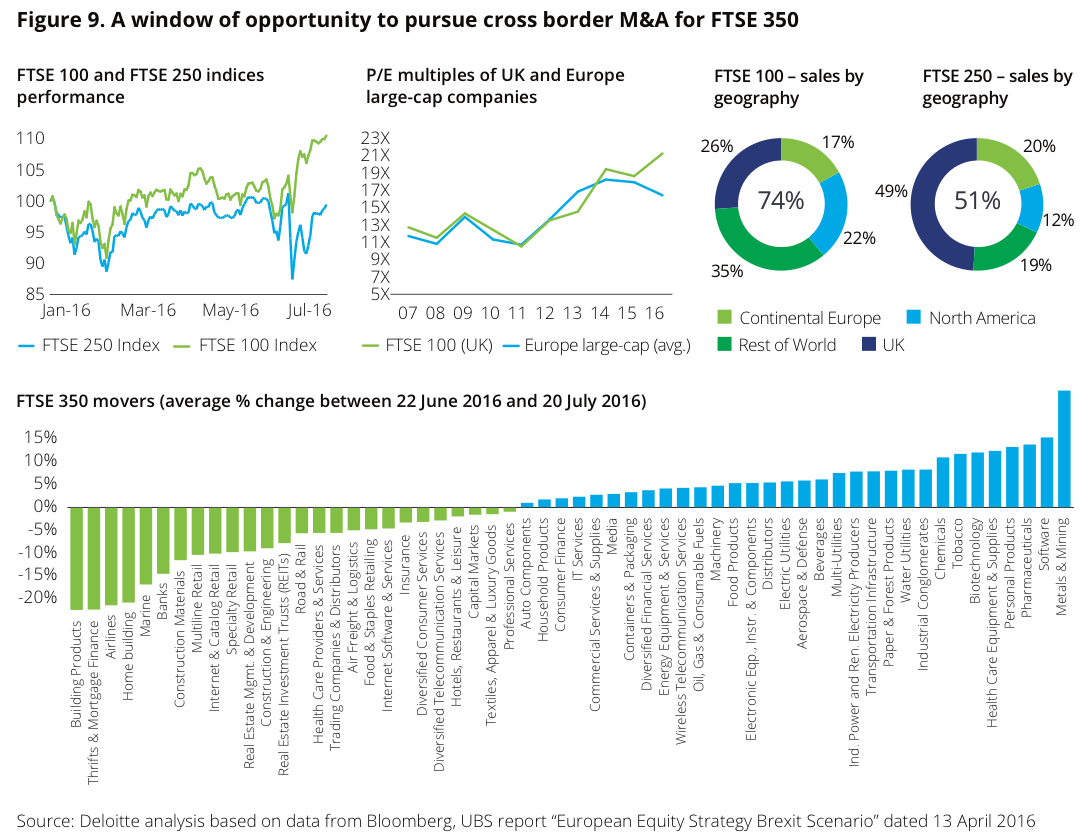
FTSE 350 M&A trends in recent years
Traditionally the UK and Europe are the two most important markets for FTSE 100 companies. In the last five years on average they have been doing 53% of their deals in these markets. But in recent years the US has started to become an important M&A market. Last year FTSE 100 companies spent $50bn on US acquisitions, compared to just $20bn on European companies outside UK. The FTSE 100 non-financial companies have around $205bn in cash reserves placing them in a good position to take advantage of potential M&A opportunities.
In recent years, FTSE 250 companies have been more active in the M&A markets than their FTSE 100 counterparts. The acquisitions by FTSE 250 companies grew by 29% from 2013 and 2015, while the activity of FTSE 100 companies declined during the same period. The UK and Europe are the two most important target markets for FTSE 250 companies; in the last five years on average they have done 67% of their deals in these markets.
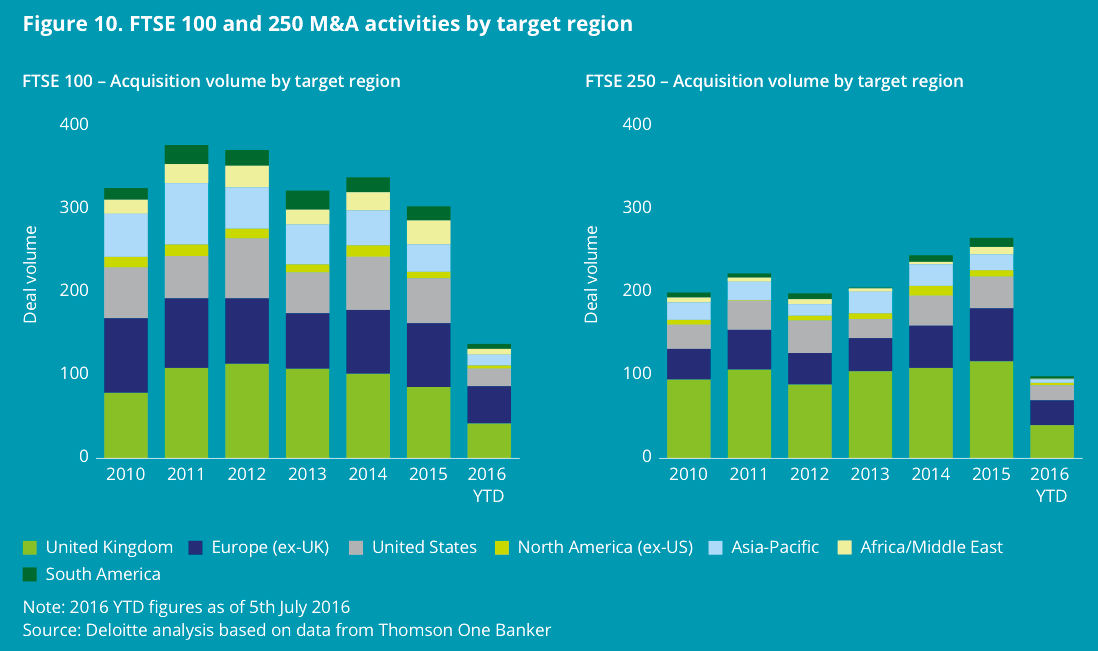
The impact of Brexit on Chinese M&A into the UK
The relative attractiveness of the UK as an investment destination for Chinese companies is clearly evident in from the M&A statistics during the last 18 months to the end of June 2016, with around 80 deals announced in the UK. Across Europe, Germany is distant second with 67 announced deals, followed by France, Italy, Netherlands, Switzerland and Spain. The megatrends supporting this, which are not directly impacted by Brexit, include:
1. China’s switch from an investment-led to consumption-led growth model, leading to deals in new sectors such as sports and entertainment
2. China’s financial institutions looking to diversify into long term, stable infrastructure and renewables assets
3. Chinese tourist boom continues to fuel investment in leisure, hotels and travel
4. Globalisation of the RMB into London’s financial centre
5. Consumer brands being acquired to be launched in China
The support of the UK Government and its ‘golden era’ policy of making the UK ‘China’s strongest partner in the west’ has 50 played an important role in encouraging Chinese investment into the UK, along with associated policies such as the loosening of the residency visa regime for private Chinese investors. In contrast, many other major markets remain relatively less welcoming, and the UK’s advanced PE industry means there is a steady flow of high-quality businesses coming to market, unlike many European countries where family ownership is more common.
Access to the EU single market from a UK base is probably less important for Chinese companies, as they have not set up manufacturing bases in the UK to use as platforms to access the EU. Many of the acquisitions are driven by acquiring a technology or brand to take back to China, or the acquisition of sales channels for Chinese manufacturing.
In the immediate aftermath of the Brexit vote, the devaluation of British pound has helped to get a couple of deals over the line, but in the months following we expect a slowdown in activity as companies wait to see what the consequences of Brexit itself are, and whether or not there is a knock-on effect in UK Government policy. The issue is less about access to the single market, and more about whether UK populism is changing the Government’s posture to China, and whether the UK will slip into recession. But in any case, growth in Chinese M&A inbound activity will likely only slow rather than go into reverse, because whilst the UK may lose some of its relative attractiveness, the pressure from within China for companies to innovate their way to growth is only growing. Additionally, we expect any slow-down to be offset by the first multi-billion deal in the UK, as the natural resources focus of the larger UK listed companies, along with the devaluation of the British pound could finally make them accessible to Chinese buyers.
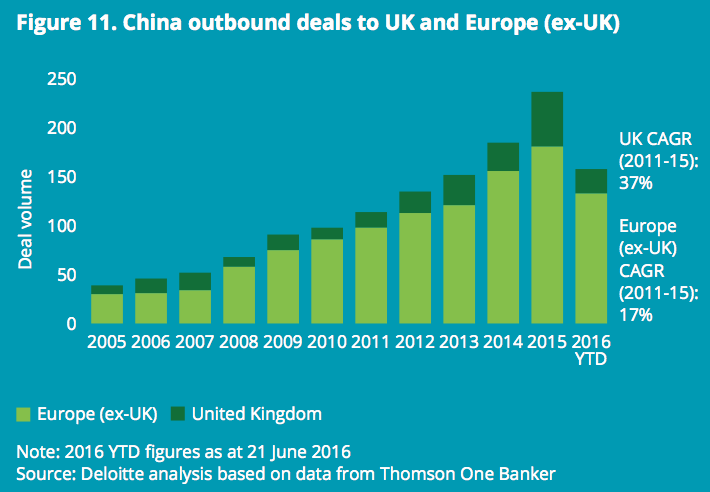
The impact of Brexit on the US/UK Deal corridor
The US/UK M&A corridor is one of the most valuable in the world and continues to show resilience amidst uncertainty. The total volume of US & UK outbound deals rose through H1, with volumes in the second quarter the highest since Q4 2014. The disclosed value of US & UK outbound M&A deals fell in the first half of 2016, with UK outbound values recovering modestly in the second quarter. US outbound value has now been above UK outbound value for three consecutive quarters.
The continued health of the US/ UK M&A channel through the first half of 2016 is the result of several powerful driving factors:
1. The funds in the US and UK are propelling the M&A market. The level of capital raising by European alternative lenders has now caught up with the US alternative lending industry, and in 2015 for the first time European funds raised more capital than their US counterparts
2. The US and UK enjoy a high and improving ‘comfort level’ in business and investment. For many US investors seeking to duplicate their ‘leading player’ business models outside their domestic market, the UK remains their first port of call, while for UK investors seeking to increase business value by adding exposure to a growing, large and predictable market, investing in US ‘bolt-on’ acquisitions can be a necessity
3. Corporates and PE on both sides of the Atlantic have large reserves of un-deployed cash reserves and “dry powder” to do deals
4. Rapid evolution of the technology sector is driving deal-making in both directions. Technology, Media & Telecoms (TMT) remains the busiest sector in transatlantic M&A, accounting for by far the most deals over the last ten quarters. From an exit standpoint, US remains a preferred option for many technology enabled UK businesses
These strong M&A drivers help account for the continued appetite in the US-UK corridor despite uncertainty and headwinds that prevail. The fundamentals for this corridor are built on long term horizons and while Brexit may cause some to pause while the policy uncertainty remains, it is likely to pick up once the situation becomes more clearer. Nonetheless, in the short term, we expect the strength of the US dollar will make certain UK assets look more attractive and this could accelerate inbound deal flows into UK.
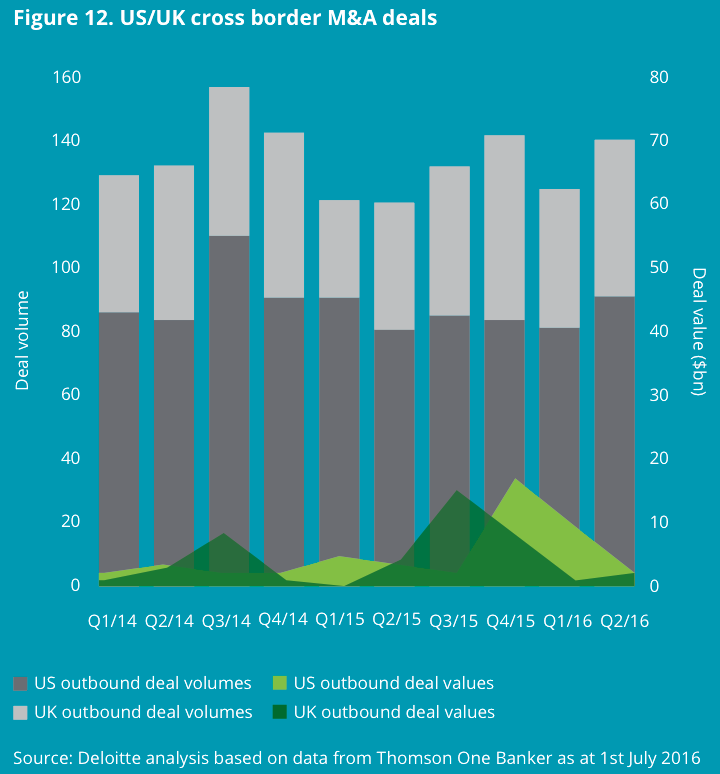
Funding conditions post-Brexit
European financial markets are likely to remain volatile over the next few months, with the British pound facing continued pressure; but currently, no London-based banks or alternative lenders are envisaging a full market shutdown in either the leveraged finance or corporate lending sectors.
The Bank of England is committed to low rates for the foreseeable future. Refinancing – normally a big driver of total volumes – is unlikely to be a big part of the second half deal flow. Most European companies have already refinanced in the last couple of years at low rates and global M&A driven financing was down 31% in the first half to US$74bn reflecting concerns around the pace of economic recovery and a slowdown in China.
One of the outcomes of the Brexit vote is that it could potentially accelerate the shift from banks to direct lending funds in the UK leveraged finance mid-market as some European banks refocus on domestic markets as opposed to pure UK deals and UK lenders face higher funding costs.
Investment grade European borrowers are likely to be largely unaffected by the vote seeing limited pricing uplifts on bonds and loans more than compensated for by falling benchmark yields; but, some mid-market purely UK borrowers could face limited pricing increases on their loans and more restricted access to bond markets subject to currency, sector and issue size.
The high yield bond markets are likely to remain volatile and uncertain, particularly for British pound issuers – post the Referendum result, higher risk assets saw large capital outflows as investors redeployed money into government bonds, US dollar, Japanese Yen and other ‘safe haven’ assets. Even pre referendum, year to date European volumes had been subdued with €24bn having been raised from 57 deals compared to last year’s first half 107 deals for €45.8bn.
In Leveraged Loans, volume in Europe reached just US$68.2bn in the first half – a drop of 47% on 2015 and the lowest first half volume since 2010. Leveraged loan structures are likely to be more conservative going forwards and lenders are likely to seek a risk premium for any business opportunity that could be impacted by Brexit.
With respect to treasury management, a need for increased levels of hedging could mean the need for increased credit lines. There could be further liquidity implications for companies who cash collateralise derivatives as larger negative fair values could result in significant collateral calls. Similarly, the potential loss of revenues or an increase in costs as a result of uncertain trading environments will mean that treasurers will need to stay close to their cash flow forecasting and actual cash conversion to manage liquidity.
In summary, the markets look set to remain volatile but open in the second half of 2016.

Preserving shareholder value in uncertain times
It is expected that in the near term elevated uncertainty will remain a feature of the UK M&A market. While it may seem prudent to wait and watch, there is a danger companies could erode shareholder value by doing so and miss out on opportunities.
In the current circumstances, reflecting caution in M&A markets, vendors need to assess planned disposals for their strengths and weaknesses and identify avenues to preserve value or capture growth opportunities. Speed is of the essence. Companies must consider strategies that are predicated on rapid identification, planning and implementation of prioritised performance improvement initiatives that will enhance cash flow, preserve profits and position the company to take advantage of opportunities.
This calls for a combined assessment of a company’s relative strategic capability, which is indicative of its ability to capture growth, and of its financial strength, which will reveal its ability to fund future growth opportunities. A comprehensive assessment of this kind will allow companies to make choices that take advantage of their distinct position and capabilities.
The prospects of Brexit means uncertainty will continue to cast some shadows over M&A and investment decisions in the UK. But companies should not simply wait and see and allow indecision to become pervasive. Unique M&A opportunities can arise from these times, and market conditions need to be closely monitored.
This way companies can continue to uncover opportunities to create value in what is likely to be a lower growth macro-environment for the foreseeable future.
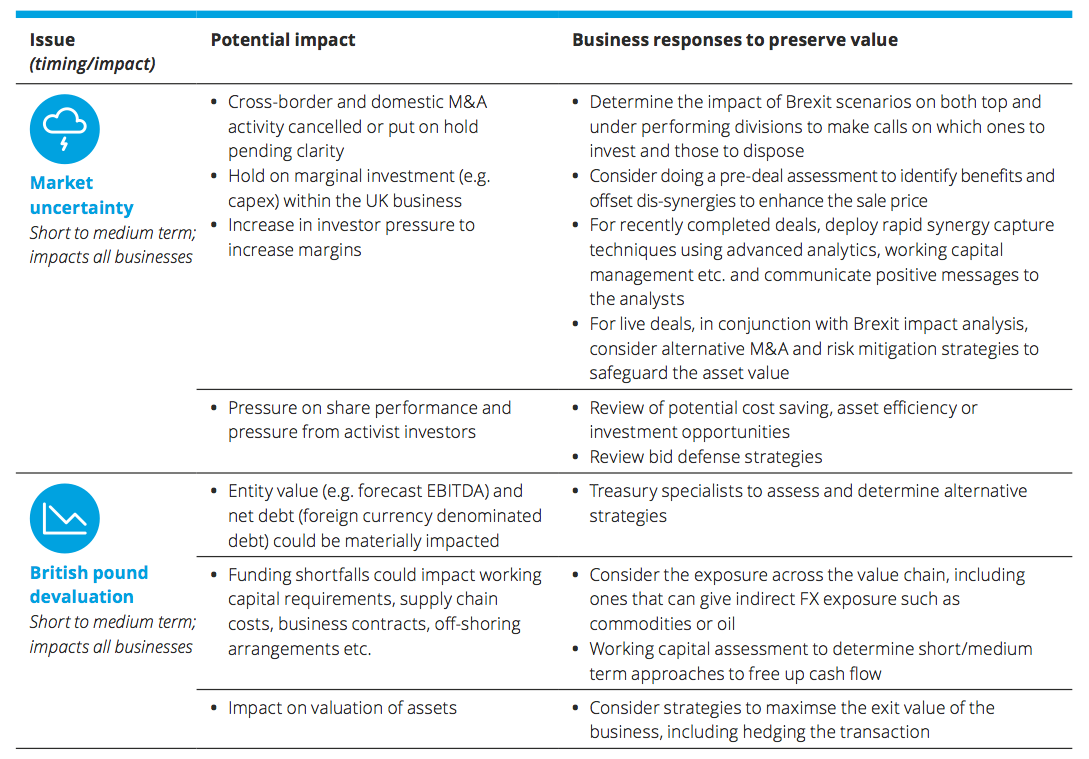
Sector outlook post-Brexit
Consumer business
Immediate impact on sectors
• The FTSE 250 Consumer Discretionary sector is down by 8.3% between 22 June 2016 and 20 July 2016 due to uncertainty about the future earnings impact on these firms
What to watch out for
• The UK runs a trade deficit with the EU across the consumer products sector. The fall in the UK British pound is likely to increase input costs in the UK, putting pressure on companies
• Retailis the UK’s largest private-sector employer and 15% of workers in retail and related wholesale operations were born abroad, with 6% born in the EU
• The average share price of non-food retailers has fallen by c. 10%
• Brexit impact more likely to be felt gradually as most retailers will be hedged against the British pound fall, consumers will take time to assess Brexit impacts
• In the medium term, squeezed margins likely through price impact of lower demand and import cost inflation from the fall in the British pound
• Retailers of big bucket/discretionary items may come under pressure
• It may provide opportunities for a number of retailers, particularly those at the discount/value end where the demand effect may offset any import-cost inflation
Impact on M&A
• Historically the M&A deal flows between the UK and EU (ex UK) has been high. Since 2011, the EU (ex UK) companies announced 347 deals ($137bn by deal value) buying UK consumer business companies and UK companies announced 436 deals ($30.9bn by deal value) buying into Europe
• Brexit impact on UK cross border deal activity is too early to assess. Some UK companies will become more attractive to foreign buyers in US dollar terms
• M&A activity is expected to continue, especially in the food & beverage segment. Retail and luxury segments have been slowing down for several months ahead of Brexit and this trend is expected to continue into early 2017
• Most retailers are keeping business as usual. The terms under which retailers do business, and even more importantly, the customers, should see little, if any, difference in the shops until the UK actually leaves the EU. Until then, maintaining customer confidence is vital
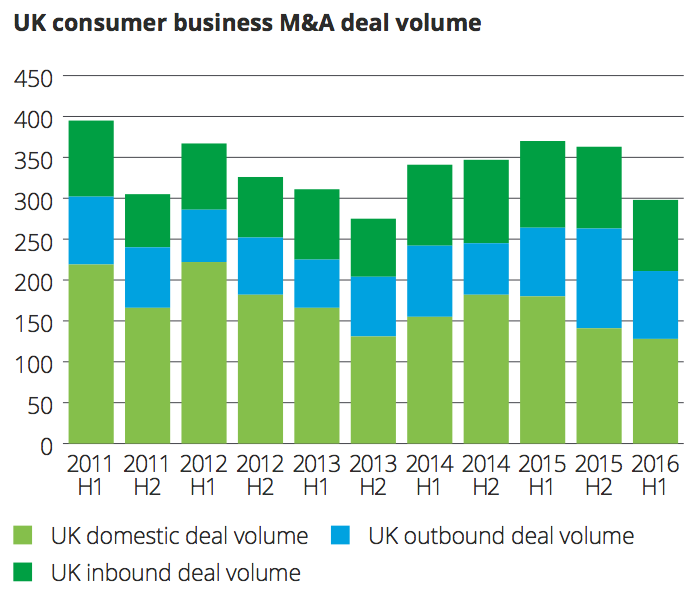
Energy and resources
Immediate impact on sectors
• Energy and resources (E&R) companies proved resilient to the Brexit vote. The share prices of these companies moved upward after the referendum
What to watch out for
• The UK buys significant amount of gas from Europe andthereisariskthatitmightbelockedoutfrom the European internal energy market
• There could be a knock on effect on infrastructure investments into the UK from overseas investors and European Funds for Strategic Investment
• It is widely expected that the fall in British pound will push up the cost of petrol
Impact on M&A
• Lower commodity prices dampen the profitability of E&R firms. With softer commodity prices and funding sources under pressure, E&R companies’ asset portfolios across the world may become acquisition targets, particularly for buyers investing with stronger currencies like US dollar and for PE firms with high amounts of dry powder
• E&R companies involving the UK engaged in deal value of $3bn in H1 2016 compared to $77bn in H1 2015. Deal volumes witnessed a decline of 12% during H1 2016
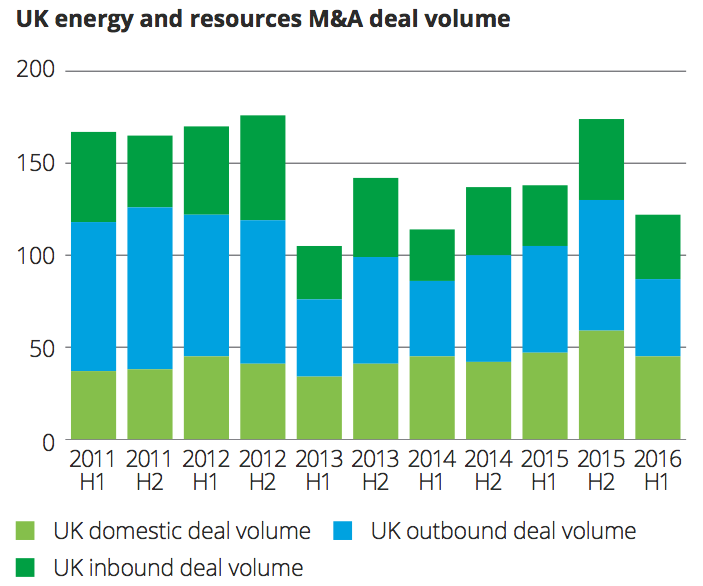
Financial services
Immediate impact on sectors
• The share prices of financial services (FS) companies were significantly impacted by the Brexit vote, both in UK and in Europe
• Banks which are part of Eurostoxx Banks Index lost €40bn between 22 June 2016 and 20 July 2016
What to watch out for
• Potential loss of passporting rights and a loss of access to European markets, together with associated significant increase in regulatory costs (impact on London and Real Estate market)
• If there is no passport to the EU there could be regulatory costs to acquire licences and will hit smaller FS companies
• Cuts to the UK credit rating will likely increase the risk premium attached to UK lenders
• If UK banks’ cost of funds does increase then this will likely be passed onto corporate borrowers gradually through higher bank loan pricing in both the leveraged and non-leveraged markets
• Many Fintech companies have located in London to take advantage of funding, talent and EU market access. This might now come under stress
Impact on M&A
• Challenger banks’ share prices were hard hit and they may come under pressure to consolidate in order to improve their return on equity
• Investment & wealth management sectors were impacted by falling asset values, so deal valuation is harder but fundamental M&A drivers remain
• Slowdown in the domestic economy may prolong ultra-low interest rates, which will hurt UK Insurers’ investment income
• While assets and liabilities should be well matched there will be significant future reinvestment risk. This could lead on to some consolidation in a similar way to the US and Japan
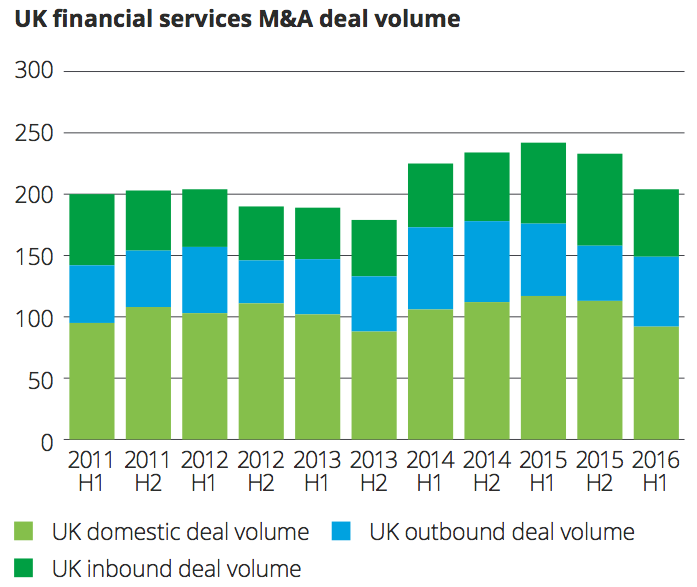
Life sciences and healthcare
Immediate impact on sectors
• Healthcare companies in the FTSE 100 rose most immediately after the Brexit vote
• For FTSE 350 life science and health care (LSHC) companies, about 90% of revenue comes from outside the UK
What to watch out for
• The European Medicines Agency which approves the medicines for EU countries is currently based in London. It might move to the EU post Brexit. There has to be clarity on how the UK regulatory system will interact with the rest of Europe
• Both health and life sciences companies are dependent on the mobility of skills across Europe, with over 10% of doctors, 4% of nurses and 15% of academic staff in UK research institutions, are from other EU countries. While the leave vote could eventually result in restrictions of the free movement of people in the EU, it may also deter other EU staff, with the requisite clinical and research skills, from choosing to work in the UK
Impact on M&A
• LSHC deal value involving UK companies declined by 17% in H1 2016. While domestic deal value increased by 52%, outbound deal value declined by 77%
• The UK’s independent healthcare market remains very fragmented although we have seen some recent consolidation through mid market PE, listed US operators and US REITs. These transactions are driven by local domestic factors such as NHS funding, demographics and the requirement for healthcare innovation to drive down cost. As such, Brexit is unlikely to have a significant impact on these smaller domestic transactions
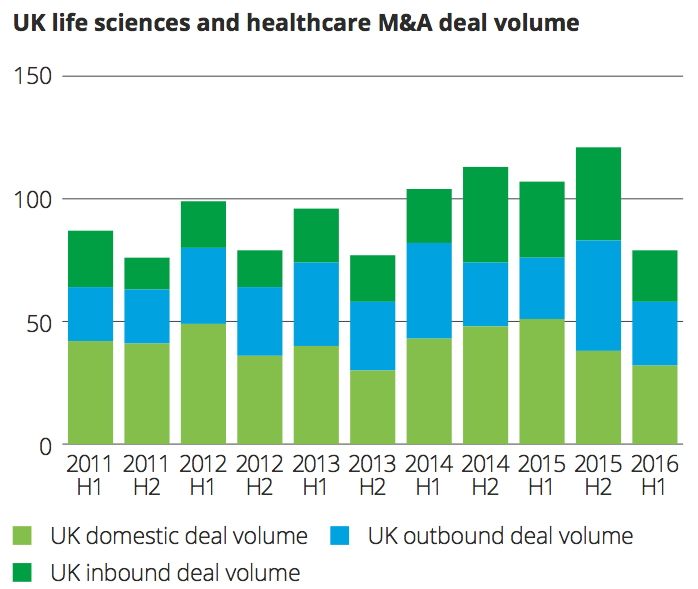
Manufacturing
Immediate impact on sectors
• The share price return between 22 June 2016 and 20 July 2016 for industrial companies which are part of FTSE 100 and 250 were 1.5% and -3.1%
What to watch out for
• Decisions on future trading agreements with the EU and UK need to be monitored as the tariff might have an impact on the trade of industrial products
• Manufacturing accounts for 10% of the UK economy. While the fall in the currency could have a positive impact for some of the companies, those reliant on a global supply chain will see their import costs go up
Impact on M&A
• UK involved deal volume in the manufacturing sector declined by 30% in H1 2016 compared to the corresponding period in 2015
• UK domestic deals declined by 45% in H1 2016 compared to the same period last year
• However, there remains good appetite for M&A involving UK and to date there has been relatively little impact on live deals

Real estate
Immediate impact on sectors
• Some of the big commercial property funds have halted redemptions. The announcement provoked steep declines in the share price of funds and companies with exposure to property
What to watch out for
• Initial concerns will likely focus on situations where there is immediate occupier risk
• Occupational demand might face a greater impact from Brexit as some of the sectors such as financial firms, pharmaceuticals and aerospace might see headcount reductions
• Relatively low availability of space both in London and the regional markets should cushion any decline in rental levels
• Investors were moving away from a capital growth driven strategy to an income-focused one; this trend is expected to be intensified
• The decline in the pound is likely to produce short-term cost inflation for parts of the construction industry where materials are sourced from overseas, adding to cost pressures
Impact on M&A
• In the first half of 2016, UK involved real estate deals declined by 28% by volume and 52% by value compared to H1 2015. While inbound and outbound deal value declined by 66% and 60%, the decline in domestic deal value was modest at 5%
• Some of the commercial property funds which are likely to be stressed due to redemptions and a probable decline in property prices might become targets
• There remains some positivity in the market that certain real estate sectors remain attractive due to a positive yield gap and continued ‘safe-harbour’ characteristics
• There may be opportunities for PE in such markets
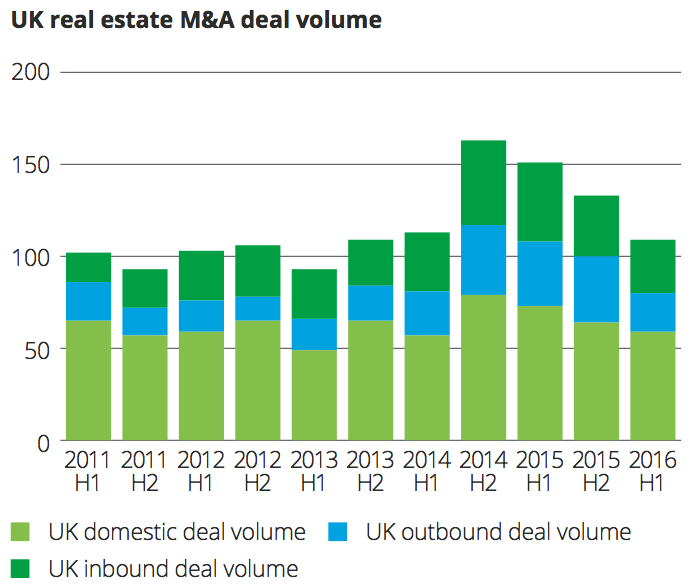
Services sector
Immediate impact on sectors
• The FTSE 350 Support Services Index increased by 2.7% between 22 June 2016 and 20 July 2016
• The recruitment companies was particularly affected as staffing and recruitment plans were put on hold by many UK companies
What to watch out for
• Exchange rate fluctuations may result in a pause in nearshoring and offshoring in the short to medium term as UK becomes more competitive in Dollar and Euro terms
• Outsourcing contracts likely be reviewed for potential impact on people constraints, data privacy, FX clauses, termination clauses etc. and decisions would be taken
• The increased cost and regulatory pressures in some sectors could spurn more outsourcing, although likely to be balanced against potential longer term restrictions
• There is a potential opportunity for increase in government outsourcing in the medium term, given number of cost and infrastructure programmes to execute against Brexit
• Some sub sectors (e.g. construction) may face multiple pressures (government spending, foreign exchange pressures, leverage levels)
• Given predominantly B2B focus and long term contract based revenues, short term impact maybe relatively minimal, but depending on the sector they serve, medium term impact is more likely
Impact on M&A
• The diverse nature of support services makes drawing broad conclusions challenging
• M&A in this sector is still being driven by long term strategic decision making. Our experience has been that whilst some deals have stalled, only a few have been formally terminated
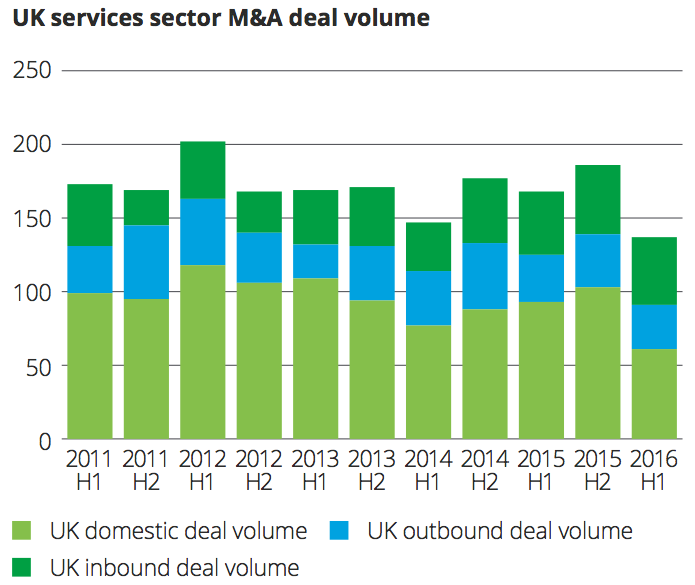
Technology, media and telecommunications
Immediate impact on sectors
• The FTSE 250 IT sector increased by 5% between 22 June 2016 and 20 July 2016
What to watch out for
• The TMT industry accounts for 8% of UK GDP and is estimated to contribute approximately £125bn to the UK economy
• Regulation: The UK model of telecommunications regulation is underpinned by the Europeans Telecoms framework. Brexit would be unlikely to result in a significant immediate change to regulation in this industry – although the longer- term impact is uncertain
• Digital single market: The impact of Brexit on e-commerce in the UK would largely depend on the exit terms negotiated between the UK and the EU but restrictions on the free movement of goods and services could have just as much impact on e-commerce as on “bricks and mortar” businesses
• Media: When there is a period of uncertainty, advertisers tend to hold back their ad spend. Advertising spend is also influenced by the economy, which is expected to experience an accelerated slowdown as a result of Brexit. Print media is at the most risk from Brexit because it is exposed to consumer demand
• Startups: Access to talent is a key consideration for the sector. There are fears that it will challenge London’s position as a hub for digital start-ups
Impact on M&A
• So far this year, M&A deal values have declined significantly in both the UK & EU (ex UK) regions compared with the same period of last year
• Interest from Asia-Pacific companies in acquiring UK assets is increasing. Since 2015, Asia-Pacific firms have made $18.5bn worth of deals in UK TMT companies, higher than the $16.6bn worth of deals made by the US
• Many UK tech businesses have a global outlook and will continue to attract investments from overseas buyers and with the IPO market cooling, this represents an opportunity for PE, subject to resilience in the debt markets
• In the Media sector some companies could become acquisition targets for international companies. But their future revenue potential will be depressed, and so it is likely that investor interest will be selective
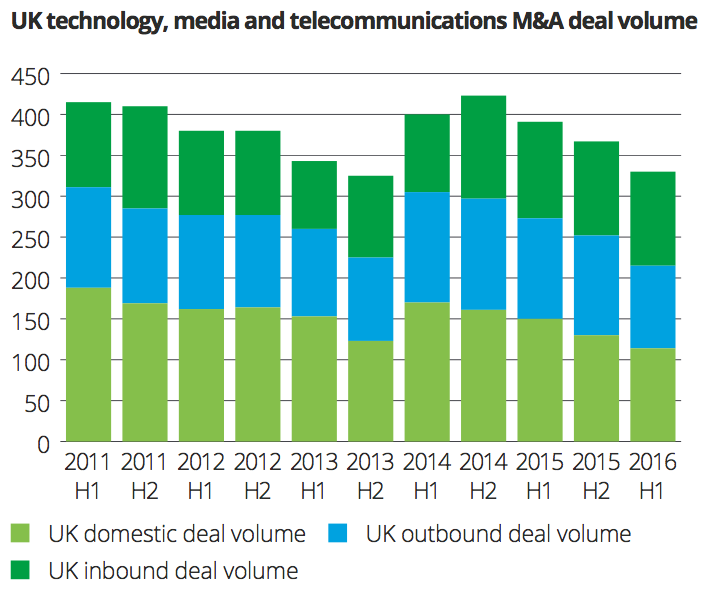
Travel and leisure
Immediate impact on sectors
• In the travel sector, airline companies which are part of FTSE 350 Index declined by 21.4% between 22 June 2016 and 20 July 2016. This illustrates the exposure to consumer demand and to exchange rates as airlines pay for aircraft leasing, maintenance and fuel in dollars but earn revenue in pounds or euros
• Other travel and leisure companies which are part of FTSE 350 Index declined by 2.6% between 22 June 2016 and 20 July 2016
What to watch out for
• There are strong travel and tourism flows between the UK and EU with significant levels of tourism spend by EU nationals. At the same time, much of the travel regulation is set at EU level and there could be a period of uncertainty whilst replacement regulations and VAT schemes are implemented
• A fall in the value of the British pound would lead to imports becoming more expensive and an increase in inflation.
• The rising cost of goods could eat into disposable incomes which could impact the leisure sector which is highly dependent on discretionary spending
• Overseas holidays could become more expensive impacting outbound tour operators (but benefiting those with a domestic focus), the eating out market could decline due to a decrease in consumer confidence and there could be a decline in hotel revenues as a result of declining corporate demand
Impact on M&A
• In the immediate aftermath of Brexit, M&A activity has largely continued – both in terms of completed deals and ongoing deal activity
• Businesses are typically highly operationally geared and therefore an economic downturn has a significant impact on the bottom line
• Foreign exchange rates are one of the biggest impacts on the leisure market. A weak pound will lead to greater inbound and domestic tourism creating significant opportunity for the sector
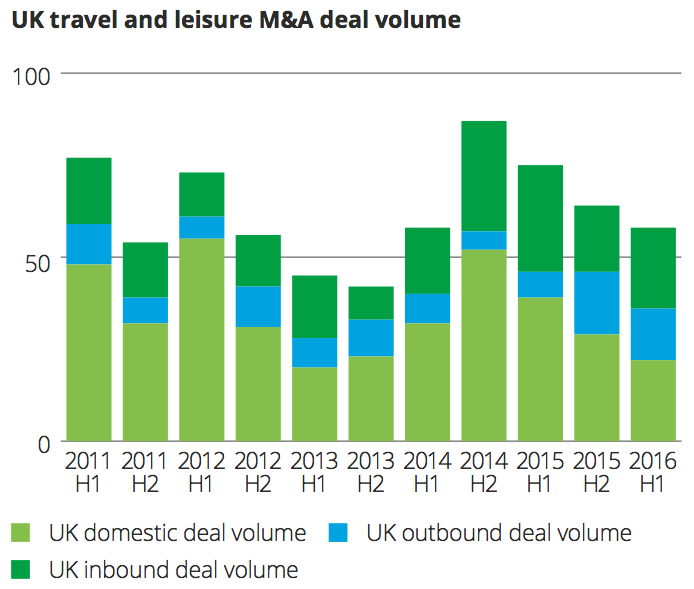
TAGS:


Stay up to date with M&A news!
Subscribe to our newsletter


